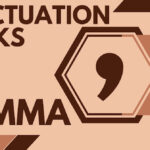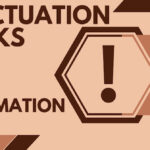Introduction
Writing is a complex and intricate process that involves more than just putting words on paper.
It requires a deep understanding of grammar, syntax, vocabulary, and most importantly, punctuation.
Punctuation marks play a crucial role in conveying meaning and ensuring clarity in writing.
Without proper punctuation, even the most well-written sentences can become confusing and ambiguous.
The Importance of Punctuation Marks in Writing
Punctuation marks are essential elements of language that guide the reader’s understanding of written text.
Their proper use can help create clear and effective communication between the writer and the reader.
Punctuation marks can help emphasize important points, indicate sentence structure, clarify meaning, and add emphasis to written words.
In addition the importance Discover of using full stops in your writing.
Learn its rules, placement, and effect on meaning with examples.
Improve your punctuation now! to their practical function, punctuation marks also play an important role in enhancing the beauty of language by creating rhythm and flow within sentences.
A well-placed comma or semicolon can transform an average sentence into a beautiful piece of literature.
Overview of the Comma as a Punctuation Mark
The comma is one of the most commonly used punctuation marks in English language writing.
It serves multiple functions such as separating clauses or items in lists or series.
The placement of commas can completely alter the meaning of a sentence.
For example:
“Let’s eat grandma”
vs
“Let’s eat, grandma”.
Another essential use for commas is separating nonessential information from essential information within sentences which helps create clarity for readers by keeping less relevant information separate from what is necessary to convey meaning.
Understanding the importance and correct usage details for each kind of punctuation mark will help improve one’s writing style immensely .
With this article breaking down all you need to know about commas , it will be much easier to understand their proper usage guidelines!
Explanation of the Comma
The comma is a punctuation mark that is used to indicate a pause or separation in a sentence.
It is one of the most common punctuation marks used in writing and is essential for clarity and readability.
The purpose of the comma is to help readers understand the intended meaning of a sentence by separating words, phrases, and clauses
.
Definition and Purpose of the Comma
The comma serves several functions in a sentence, including separating items in a list or series, setting off introductory words or phrases, separating independent clauses in compound sentences, and setting off nonessential information.
For example
consider this sentence:
“I need to buy eggs milk cheese bread and butter at the store.”
Without commas, it can be confusing to read and interpret what exactly needs to be bought from the store.
However, by adding commas between each item
(i.e., “I need to buy eggs, milk, cheese, bread, and butter at the store.”),
it becomes clear that there are five separate items on the shopping list.
Types of Commas
One common type of comma is known as the Oxford comma or serial comma.
This refers to an optional comma placed before the conjunction (e.g., “and” or “or”) in a list or series of three or more items.
For example:
“I have three favorite colors: red blue[,] and green.”
The Oxford comma is often debated among writers; however its use can add clarity by avoiding ambiguity caused by leaving out that final separator.
Another type of comma includes those used with dependent clauses – adverbial clauses (an adverbial clause modifies verbs), noun clauses (a subordinate clause that acts as a noun), relative clauses (adjectival clause), etc.
Common Misconceptions About Using Commas
One common misconception about using commas is that they should be used to indicate a pause in speech.
While some writers might use commas this way, it’s not their primary purpose.
Commas are actually used to separate and group related words, phrases, or clauses within sentences.
Another misconception is that commas can be used interchangeably with other punctuation marks.
For example, colons and semicolons cannot be substituted for commas as they serve distinct purposes in writing.
Understanding the proper use of the comma is essential for clear and effective writing. It can help avoid misunderstandings and improve readability when employed effectively without adding confusion or ambiguity.
Rules for Using Commas in Sentences
Separating Items in a List or Series
One of the most common uses of commas is to separate items in a list or series.
This rule applies when there are three or more items in the list.
For example:
“I need to buy apples, bananas, and oranges at the grocery store.”
Note that there is a comma after each item except for the last one, which is separated by “and”.
This is known as the Oxford comma or serial comma and makes it clear that all items in the list are separate and distinct.
Separating Independent Clauses in a Compound Sentence
Another important use of commas is to separate independent clauses in a compound sentence.
An independent clause is a complete sentence on its own.
When two independent clauses are joined together with a conjunction such as “and”, “but”, or “or”, they form a compound sentence.
For example:
“I went for a run this morning, and then I took a shower.”
Note that there is a comma before the conjunction because each clause could stand on its own as its own sentence if separated.
Setting Off Introductory Words or Phrases
Commas are also used to set off introductory words or phrases at the beginning of sentences.
This includes words like “however”, “consequently”, and phrases like “in addition”.
For example:
“After finishing my homework, I decided to watch TV.”
The phrase “after finishing my homework” is set off by commas because it introduces the main clause that follows.
Setting Off Nonessential Information
Commas can be used to set off nonessential information from the rest of the sentence.
Nonessential information refers to details that could be removed from the sentence without changing its meaning.
For example:
“My friend Sarah, who lives next door, is coming over for dinner tonight.”
The phrase “who lives next door” is nonessential information because it is not necessary to understand the main point of the sentence.
It is set off by commas to indicate that it could be removed without affecting the sentence’s meaning.
Avoiding Overusing Commas
While commas are an essential part of writing, it’s important to use them judiciously.
Overuse of commas can clutter sentences and make them difficult to read.
Remember that commas should only be used when necessary for clarity or grammar.
If in doubt, read your sentence out loud and see if you naturally pause where a comma would go.
If not, you might not need one.
Also, review your work after writing it with a focus on making sure there are no unnecessary or missing commas throughout your content.
Examples of proper use of commas in sentences
List example:
I need to buy apples, bananas, and oranges at the grocery store.
One common use of commas is to separate items in a list or series.
This helps to clarify the meaning of a sentence and make it easier for readers to understand.
In the above example sentence, the comma is used to separate three different types of fruit that the speaker needs to buy at the grocery store: apples, bananas, and oranges.
Without the comma, this sentence could be misinterpreted as referring to a single type of fruit called “apples bananas” that also happens to come in an “orange” variety.
By using a comma between each item in the list, however, the reader can clearly see that these are three distinct types of fruit that are all needed.
Other examples where commas can be used for lists include things like ingredients for a recipe
(e.g., “To make this soup you will need carrots, onions, celery, and potatoes.”)
or names of people or things (e.g., “My favorite colors are red, green, blue, and yellow.”).
Compound sentence example:
I went for a run this morning, and then I took a shower.
Another use of commas is to separate independent clauses in a compound sentence.
A compound sentence is made up of two or more independent clauses (i.e., complete sentences) that are joined together by coordinating conjunctions such as “and,” “but,” or “or.”
In this example sentence above we have two independent clauses separated by comma;
“I went for a run this morning” and “then I took shower”.
Without using comma it will create confusion about whether these two phrases are connected.
Proper usage helps readers follow along more easily with what is happening in your writing.
Knowing how and when to properly use commas will ensure that the meaning you intend to convey is clear.
Introductory phrase example:
After finishing my homework, I decided to watch TV.
Using a comma after an introductory phrase helps to set it off from the main clause of the sentence.
Introductory phrases can be made up of words like “after,” “although,” “because,” and “when.”
The comma shows where the introductory phrase ends and where the rest of the sentence begins.
In this example sentence, the introductory phrase is “After finishing my homework”.
Without a comma following this phrase, the reader might interpret “decided” as part of that same thought or action
(i.e., as if you were deciding while doing your homework), rather than as a new and separate thing you did after finishing.
A common error in writing that writers can avoid with proper usage is not including a comma after an introductory word or phrase.
For instance, making errors such as
‘After I finish my work I will eat’ instead of ‘After I finish my work, I will eat’.
Nonessential information example:
My friend Sarah, who lives next door, is coming over for dinner tonight.
A nonessential element in a sentence provides additional information about a noun or pronoun but does not change its meaning; it’s just extra information that provides more detail.
Nonessential elements are usually surrounded by commas to indicate that they are optional parts of a sentence that could be taken out without altering its basic meaning.
In this example sentence, “who lives next door” is nonessential because we already know which Sarah we’re talking about — our friend who we know well enough to invite over for dinner.
Her address being specified here isn’t necessary for understanding who she is.
Commas help readers identify what parts of sentences are essential versus what information can be left out without changing their core meaning.
Writing with proper punctuation can both improve the readability of your writing and ensure that your intended message is unmistakably clear.
Conclusion
Mastering Commas for Effective Writing
Using commas correctly is essential for effective writing.
Commas serve the critical purpose of clarifying sentence meaning and structure.
Incorrect comma usage can lead to confusing or ambiguous sentences, which can negatively impact the reader’s understanding of your message.
It is crucial to understand the rules of comma usage and practice implementing them in your writing.
To recap, we have discussed the definition and purpose of commas, different types of commas, common misconceptions about using commas, and rules for using them in sentences.
We have also provided several examples of proper comma usage to illustrate these rules in practice.
The Importance of Practicing Proper Punctuation
Practicing proper punctuation is a vital aspect of improving your writing skills.
It ensures that you convey your intended message with clarity and precision, making it easier for readers to understand and engage with your content.
While it may seem tedious or insignificant at times, mastering punctuation marks such as commas will ultimately help you become a more effective communicator.
So next time you’re writing an email or crafting a professional document, take some extra time to review your use of commas and other punctuation marks.
Remember that becoming proficient at using punctuation takes practice.
The more you work on it, the better you will become over time.
With consistent effort and attention to detail, anyone can master comma usage and elevate their writing skills to new heights!





6 thoughts on “Comma Punctuation Marks”